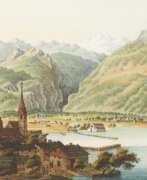Porcelain painters 18th century


Jean-Jacques Bachelier was a French painter and innovator of porcelain and a member of the Royal Academy of Painting and Sculpture.
Originally a still-life painter, he later became world-renowned for his significant contributions to applied art. In 1765, Bachelier founded an art and crafts school in Paris with his own funds. He was in charge of the painters at the porcelain manufactory in Vincennes, where figures were produced from unglazed porcelain - biscuit. For many years Bachelier was the Director of Sevres porcelain manufactory and in fact became the creator of the Sevres style.
Bachelier also conducted research on encaustic painting (a painting technique in which the binding substance of paints is wax) and published works on art education.


Johann Heinrich Bleuler the Elder was a Swiss landscape painter and engraver.
Bleuler the Elder first trained as a porcelain painter at the Kilchberg-Schooren porcelain manufactory near Zurich. In the early 1780s he settled in Feuertalen and became the founder of the dynasty of artists that is known as the "Bleulerische Malschule". His two sons, Johann Heinrich Bleuler the Younger (1787-1857) and Johann Ludwig Bleuler (1792-1850), also became artists and continued their father's work. And in total, there were up to 25 artists in the dynasty, including godchildren and other relatives.
Bleuler the Elder created mainly landscapes of the Rhine, painted in gouache and watercolor, panoramic views of Swiss cities. He also worked as an art teacher.


Johann Baptist Drechsler was an Austrian floral artist. He was born into a family of porcelain painters and worked for ten years at the Viennese porcelain manufactory. He is known for his colorful floral still lifes, including fruit and birds.


Frédéric Théodore Faber was a Belgian landscape and genre painter. He established at Brussels a china manufactory, and abandoned painting on canvas for painting on porcelain. He also etched upwards of a hundred plates of landscapes and animals, some after his own designs.
A significant set of pieces painted by this virtuoso is exhibited at the Museum of Decorative Arts François Duesberg.


Johann Gregor Höroldt was a German porcelain artist who developed the Meissen porcelain style. Höroldt was trained as a miniature and enamel painter.
Between 1719 and 1720 he worked at the porcelain manufactory in Vienna, recently founded by Du Pacquier, and then moved to Meissen and began his collaboration with the Meissen Porcelain Manufactory. In 1724 he was appointed court painter. In 1731, Höroldt became an arcanist (a chemist, a key figure in porcelain production), and was simultaneously appointed head of the entire painting department and court commissioner.
Höroldt influenced virtually all European porcelain and faience manufactories. He specialized in the fashionable and popular chinoiserie design, but also introduced European landscapes, harbor and battle scenes, still lifes, and bird images as porcelain decoration.
The artist also significantly expanded the palette of colors used in Meissen: in the early XVIII century. was available only five paints for glaze, and Höroldt by 1731 increased the palette to 16 colors. He attached great importance and the original form for porcelain, trying to make it different from the usual dishes.


Georgius Jacobus Johannes van Os was a 19th-century painter from the Northern Netherlands. He was a son and pupil of the painters Jan van Os and Susanna de la Croix, and a brother of the painters Pieter van Os and Maria Margaretha van Os. In 1809 he won the first prize of the Society Felix Meritis in Amsterdam for a still life in which genre he later specialized. In 1822 he moved to Paris, where he worked for the Sèvres porcelain factory. He painted landscapes, but was, like his father, best known as a painter of flowers. Starting in the 1830s he spent his summers in Haarlem, where he continued working on flower illustrations for the "Flora Batava" edited by Jan Kops. He is not to be confused with the son of his brother Pieter, also a painter called Georgius Jacobus Johannes van Os, but who lived from 1805-1841 and continued the family painting tradition.



















